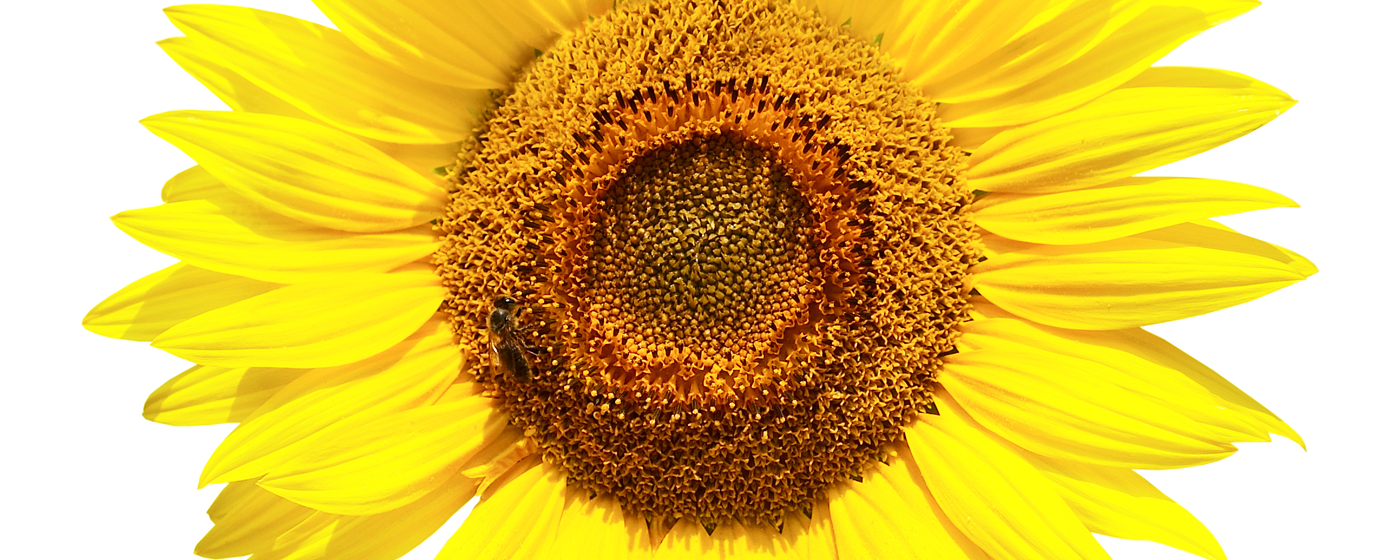Sunflower
The sunflower is characterised by its yellow flower and its long stem, which can measure up to five metres. Native populations in North America first grew the sunflower for its edible seeds, its oil and as a source of dye. In the 16th century, it was introduced into Europe, where it was used as an ornamental plant, then as an oilseed crop from the 19th century. Nowadays, it is grown in various regions across the world, as it is able to tolerate intertropical and temperate climates.
The sunflower’s American origin
Native populations in North America originally grew the sunflower for its edible seeds, its oil and as a source of dye. In the 16th century, it was introduced into Europe, where it was first used as an ornamental plant. From the 18th century, the sunflower was grown in Russia for its oil, as it was the only fat allowed by the Orthodox Church during Lent. In the 19th century, its cultivation as an oilseed crop extended across the whole of Europe. Nowadays, the sunflower is grown mainly for its seeds, which constitute one of the main sources of edible oil in the world and an important element of human and animal diets.
A hardy, easy-to-grow plant
The sunflower is tolerant of drought, wet conditions and frost. It can grow in both intertropical and temperate regions. It adapts to various types of soil, whether they are sandy or clay. It is, however, intolerant to salt.
An annual plant, it reproduces naturally through pollination. As sunflowers require a long season to reach maturity, the seeds are generally sown in May. They need to be buried fairly deep (up to 10 centimetres) or in soil which is sufficiently moist to allow them to germinate. Weeds must be removed once the sunflower begins to grow, as it is unable to tolerate competition. The plant is mature when the underneath of the inflorescence is yellow and the bracts (the small leaves on the inflorescence) turn brown. The sunflower is harvested in October, when the water content of the seeds is lower than in summer and the seeds are therefore more favourable to the production of oil.
An inflorescence with thousands of flowers
The sunflower belongs to the family of Composites or Asteraceae, along with the dandelion and the thistle. The inflorescence, called the capitulum, is composed of many tiny flowers. Although it may appear simple, the sunflower’s capitulum contains thousands of flowers (up to 20 000) arranged side by side, forming a flat disk surrounded by yellow petals. The colour of the flowers can vary from lemon yellow to a reddish-orange and the disk which they form can measure up to 50 centimetres in diameter.
After the flowers have been fertilised, greyish green or black oval-shaped seeds develop. The seeds are protected by a grey or black shell, sometimes with black and white stripes. If fertilisation does not occur, the shell remains empty.
The plant’s stem usually measures between 1 and 2 metres, but can reach up to 5 metres. Its leaves are petiolate (they are connected to the plant by a small stem), triangular and serrated.
Common and scientific names
The common French name tournesol and the Spanish name girasol, come from a legend that the flowers turn to track the movement of the sun during the day. Its scientific name Helianthus, from the Greek 'helios', sun and 'anthos', flower, refers to the shape of the flower resembling that of the sun. The English and German names are literal translations of the scientific name: sunflower and Sonnenblume.
CHAVEROUX, Sophie, 2014. Le tournesol : une culture pour le futur. INRA І Institut national de la recherche agronomique. 31 octobre 2014 [en ligne]. [Consulté le 10 décembre 2015]. Disponible à l’adresse : http://www.inra.fr
DEDIO, W., 2015. La biologie de l'Helianthus annuus L. (tournesol). Bureau de la biosécurité végétale du Canada, 4 février 2015 [en ligne]. [Consulté le 10 décembre 2015]. Disponible à l’adresse : http://www.inspection.gc.ca
GNIS pédagogie. S. d. Origine et physiologie du tournesol. GNIS pédagogie [en ligne]. [Consulté le 10 décembre 2015]. Disponible à l’adresse : http://www.gnis-pedagogie.org
INFO FLORA І CENTRE NATIONAL DE DONNÉES ET D'INFORMATIONS SUR LA FLORE DE SUISSE. Helianthus annuus L. Info Flora І Centre national de données et d'informations sur la flore de Suisse [en ligne]. [Consulté le 10 décembre 2015]. Disponible à l’adresse : https://www.infoflora.ch
KARTIKA, Ika Amalia, 2005. Nouveau procédé de fractionnement des graines de tournesol : expression et extraction en extrudeur bi-vis, purification par ultrafiltration de l’huile de tournesol [en ligne]. thèse de doctorat. Laboratoire de Chimie Agro-Industrielle. INRA | Institut national de la recherche agronomique. [Consulté le 10 décembre 2015]. Disponible à l’adresse : http://ethesis.inp-toulouse.fr
NYABYENDA, Pierre, 2006. Le tournesol. In : Les plantes cultivées en régions tropicales d'altitude d'Afrique: Cultures industrielles et d'exploitation. Cultures fruitières. Cultures maraîchères [en ligne]. Gembloux : Presses agronomiques. 2006. pp. 110-115. [Consulté le 10 décembre 2015]. Disponible à l’adresse : https://books.google.ch
POUSSET, Joseph, 2008. Le tournesol. In : Agriculture naturelle: face aux défis actuels et à venir, pourquoi et comment généraliser une pratique agricole productive [en ligne]. Paris : Agridécisions. 2008. pp. 339-340. [Consulté le 10 décembre 2015]. Disponible à l’adresse : https://books.google.ch
VAROQUAUX, Claire Doré, F., 2006. Le tournesol. In : Histoire et amélioration de cinquante plantes cultivées [en ligne]. INRA | Institut national de la recherche agronomique. 2006. p. 713. [Consulté le 10 décembre 2015]. Disponible à l’adresse : https://books.google.ch



